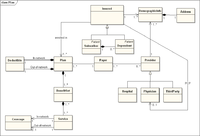Conceptual model (computer science)

A conceptual model in computer science is like playing with toy blocks. Imagine you have a set of blocks in different shapes and colors, and you want to build something, like a castle.
First, you need to make a plan in your mind of what you want to build. This plan is like a conceptual model. It defines the details of your castle, like the number of towers, the height of walls, the colors you'll use, and the rooms inside.
Then, you start picking blocks and putting them together, following your plan step by step. Each block represents an object or a function in computer science, like a button on a webpage or a database query.
As you build, you may find that some blocks don't fit well, or that you need more blocks of a certain type. This is normal, and you can adjust your plan to accommodate these changes.
Once you finish building your castle, you can play with it, change it, or even break it apart and build something new.
Similarly, in computer science, a conceptual model is a plan or a blueprint that defines the structure, behavior, and interactions of software components. It helps developers understand the logic behind the software and communicate their ideas with others. They can refine the model as they code and test the software, and update it over time as needed.
First, you need to make a plan in your mind of what you want to build. This plan is like a conceptual model. It defines the details of your castle, like the number of towers, the height of walls, the colors you'll use, and the rooms inside.
Then, you start picking blocks and putting them together, following your plan step by step. Each block represents an object or a function in computer science, like a button on a webpage or a database query.
As you build, you may find that some blocks don't fit well, or that you need more blocks of a certain type. This is normal, and you can adjust your plan to accommodate these changes.
Once you finish building your castle, you can play with it, change it, or even break it apart and build something new.
Similarly, in computer science, a conceptual model is a plan or a blueprint that defines the structure, behavior, and interactions of software components. It helps developers understand the logic behind the software and communicate their ideas with others. They can refine the model as they code and test the software, and update it over time as needed.
Related topics others have asked about:
